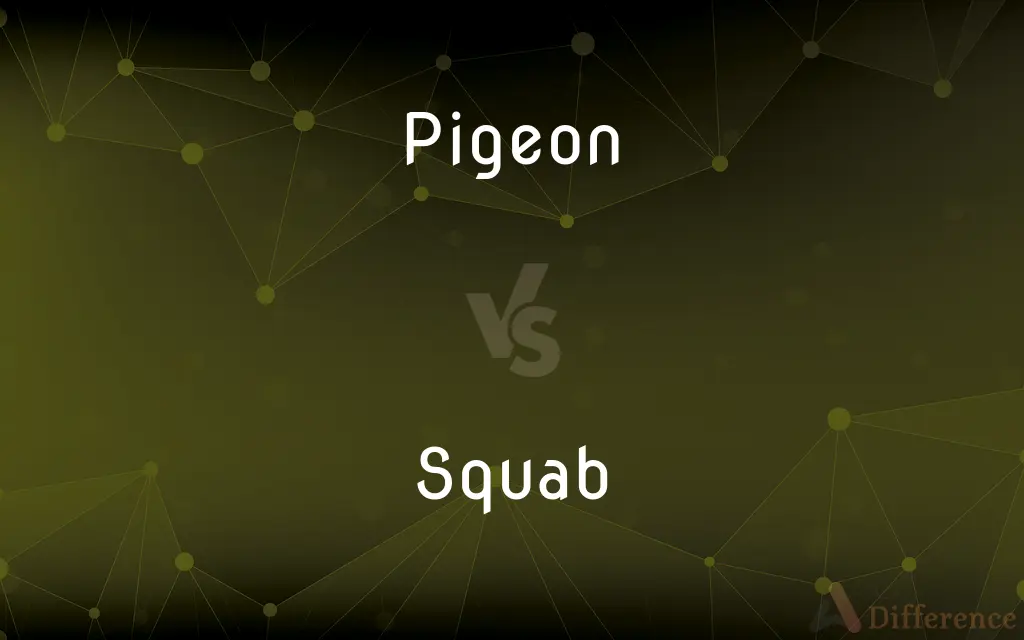Pigeon vs. Squab — What's the Difference?
By Tayyaba Rehman & Urooj Arif — Updated on April 20, 2024
A pigeon is a bird belonging to the Columbidae family, known for its widespread presence globally, while a squab refers specifically to a young pigeon that is typically under four weeks old and often raised for culinary purposes.

Difference Between Pigeon and Squab
Table of Contents
ADVERTISEMENT
Key Differences
Pigeons are birds noted for their ability to adapt to various environments, including urban and wild areas. They are known for their distinct cooing sound and ability to return home over long distances. In contrast, squab is the term used for young pigeons, not yet fully matured, and is particularly associated with the bird when it is used in cooking.
Pigeons have a varied diet that can include seeds, fruits, and plants, and they are often seen feeding in groups in urban settings. Squabs, on the other hand, are fed "pigeon milk" — a nutrient-rich substance regurgitated by the parent birds — and are considered a delicacy in many culinary traditions due to their tender meat.
In terms of reproduction, pigeons can breed multiple times a year, laying one or two eggs per breeding cycle. Squabs are the product of these breeding efforts, and they remain in the nest, dependent on their parents until they are ready to fledge. This period of dependence is when they are often harvested for food if they are being raised in a controlled environment like a pigeonry.
Culturally, pigeons have been symbols of peace and communication, frequently used as messengers during war times due to their homing abilities. Squabs do not have this broader cultural significance but are rather prized in gastronomy, particularly in French and Middle Eastern cuisines.
While pigeons are often considered a nuisance in cities due to their droppings and the potential diseases they can spread, squabs are generally viewed through the lens of agriculture and gastronomy, where they are bred under specific conditions to ensure the quality and safety of the meat produced.
ADVERTISEMENT
Comparison Chart
Definition
A bird from the Columbidae family, widespread and adaptable.
A young pigeon, typically under four weeks old, often raised for meat.
Diet
Seeds, fruits, plants.
Pigeon milk from parents, when young.
Role in Culture
Symbol of peace, used historically as messengers.
Valued in culinary practices, especially in fine dining.
Breeding
Breeds multiple times a year, laying 1-2 eggs each time.
Stays in the nest, dependent on parents until fledging.
Common Perception
Often seen as a nuisance in urban areas.
Considered a delicacy in various cuisines.
Compare with Definitions
Pigeon
Known for their homing ability, used historically for carrying messages.
Pigeons were vital communication tools in World War II.
Squab
Known for its tender meat, a result of its diet and limited movement before fledging.
Squab is prized for its soft, delicate flavor.
Pigeon
A bird of the family Columbidae, known for its stout body and short neck.
The city park is home to many pigeons.
Squab
Raised in a controlled environment for food production.
Squab farming is a niche but lucrative aspect of agriculture.
Pigeon
Often found in urban areas, feeding on various plant-based foods.
Pigeons gathering at the square are a common sight.
Squab
A young pigeon used as food, especially in gourmet cooking.
The menu features roasted squab with a cherry glaze.
Pigeon
Can live in a wide range of environments from cities to rural areas.
Pigeons adapt easily, thriving in nearly any environment.
Squab
Typically harvested before they can fly, ensuring meat quality.
Squabs are usually taken from the nest just before they are ready to fly.
Pigeon
Considered by some as pests due to their droppings and disease potential.
Building owners often install spikes to deter pigeons.
Squab
Featured in various international cuisines, including French and Middle Eastern.
Squab is often stuffed with rice and spices in Middle Eastern dishes.
Pigeon
A stout seed- or fruit-eating bird with a small head, short legs, and a cooing voice, typically having grey and white plumage.
Squab
In culinary terminology, squab is a baby domestic pigeon, typically under four weeks old, or its meat. The meat is widely described as tasting like dark chicken.
Pigeon
A gullible person, especially someone swindled in gambling or the victim of a confidence trick.
Squab
A young, newly hatched, or unfledged pigeon.
Pigeon
An aircraft from one's own side.
Squab
A soft, thick cushion, as for a couch.
Pigeon
Archaic spelling of pidgin
Squab
A couch.
Pigeon
A person's particular responsibility or business
Hermia will have to tell them first, it's her pigeon
Squab
Young and undeveloped; newly hatched or unfledged
A squab chick.
Pigeon
Any of various birds of the widely distributed family Columbidae, characteristically having plump bodies, small heads, and short legs, especially the rock pigeon or any of its domesticated varieties.
Squab
A baby pigeon, dove, or chicken.
Pigeon
(Slang) One who is easily swindled; a dupe.
Squab
The meat of such a baby bird used as food.
Pigeon
An object of special concern; an affair or matter.
Squab
A baby rook.
Pigeon
One of several birds of the family Columbidae, which consists of more than 300 species.
Squab
A thick cushion, especially a flat one covering the seat of a chair or sofa.
Pigeon
(uncountable) The meat from this bird.
Squab
A person of a short, fat figure.
Pigeon
A person who is a target or victim of a confidence game.
Squab
(obsolete) To fall plump; to strike at one dash, or with a heavy stroke.
Pigeon
A pacifist, appeaser, an isolationist, a dove.
Squab
(transitive) To furnish with squabs, or cushions.
Pigeon
A person hired to transport film footage out of a region where transport options are limited.
Squab
(transitive) To stuff thickly and sew through, the stitches being concealed by buttons, etc.
Pigeon
A weak or useless person.
Squab
Fat; thick; plump; bulky.
Pigeon
Concern or responsibility.
It's his/her pigeon.
Squab
Unfledged; unfeathered.
Pigeon
(transitive) To deceive with a confidence game.
Squab
Clumsy.
Pigeon
Any bird of the order Columbæ, of which numerous species occur in nearly all parts of the world.
Squab
Curt; abrupt.
Pigeon
An unsuspected victim of sharpers; a gull.
Squab
Shy; coy.
Pigeon
To pluck; to fleece; to swindle by tricks in gambling.
He's pigeoned and undone.
Squab
(slang) With a heavy fall; plump.
Pigeon
Wild and domesticated birds having a heavy body and short legs
Squab
Fat; thick; plump; bulky.
Nor the squab daughter nor the wife were nice.
Squab
Unfledged; unfeathered; as, a squab pigeon.
Squab
A nestling of a pigeon or other similar bird, esp. when very fat and not fully fledged.
Squab
A person of a short, fat figure.
Gorgonious sits abdominous and wan,Like a fat squab upon a Chinese fan.
Squab
A thickly stuffed cushion; especially, one used for the seat of a sofa, couch, or chair; also, a sofa.
Punching the squab of chairs and sofas.
On her large squab you find her spread.
Squab
With a heavy fall; plump.
The eagle took the tortoise up into the air, and dropped him down, squab, upon a rock.
Squab
To fall plump; to strike at one dash, or with a heavy stroke.
Squab
Flesh of a pigeon suitable for roasting or braising; flesh of a dove (young squab) may be broiled
Squab
A soft padded sofa
Squab
An unfledged pigeon
Squab
Short and fat
Common Curiosities
What role do pigeons play in the ecosystem?
Pigeons help in seed dispersal due to their diet of grains and seeds, contributing to plant regeneration and growth.
Are squabs farmed differently from other poultry?
Yes, squabs are usually raised in specialized pigeonries or lofts, and they are not allowed to forage or move extensively, which keeps their meat tender.
What are the main differences in the habitats of pigeons and squabs?
Pigeons are adaptable and can thrive in varied environments from urban areas to cliffs and rural settings, whereas squabs remain in the nest and are dependent on the protection and location chosen by their parents.
How long do pigeons live?
Pigeons typically live for 3 to 5 years in the wild, but they can live up to 15 years in captivity.
How are pigeons able to find their way home?
Pigeons possess an extraordinary homing ability, likely relying on a combination of magnetic fields, the position of the sun, and visual landmarks to navigate.
Can you eat any pigeon or just squabs?
While technically all pigeons are edible, squabs are preferred for eating due to their tender meat, resulting from their young age and controlled diet.
How often do pigeons breed, and what is their breeding cycle like?
Pigeons can breed up to six times a year, with each cycle involving laying one or two eggs and a nesting period of about 18 days followed by another 35 days for the squabs to be ready to leave the nest.
What is the significance of pigeons in historical and cultural contexts?
Historically, pigeons were used as messengers due to their homing capabilities and have been symbols of peace, love, and loyalty in various cultures.
How do pigeons feed their young?
Pigeons feed their squabs a substance known as pigeon milk, which is regurgitated by both parents.
Why are pigeons considered pests?
Pigeons are often viewed as pests in urban areas due to their droppings, which can damage buildings and spread diseases.
Can squabs fly when they are taken for culinary use?
No, squabs are generally harvested before they are mature enough to fly, typically around four weeks old.
What preventive measures can be taken against pigeon-related nuisances?
Preventive measures include installing bird deterrents like spikes or nets, managing waste food sources, and sometimes employing birth control methods to manage population sizes.
What is pigeon milk made of?
Pigeon milk is actually a secretion produced by the lining of the crop of parent birds, rich in fat and protein, crucial for the growth of squabs.
Are there different breeds of pigeons, and how do they differ?
There are numerous breeds of pigeons, including fancy breeds for shows, racing breeds known for their speed and endurance, and utility breeds raised primarily for meat production like squabs. Each breed has distinct characteristics such as plumage, body size, and behavior.
What distinguishes a pigeon from a squab?
A squab is specifically a young pigeon, particularly noted for its culinary use, whereas a pigeon refers to the bird in general, regardless of age.
Share Your Discovery

Previous Comparison
Exonerated vs. Pardon
Next Comparison
Melatonin vs. SerotoninAuthor Spotlight
Written by
Tayyaba RehmanTayyaba Rehman is a distinguished writer, currently serving as a primary contributor to askdifference.com. As a researcher in semantics and etymology, Tayyaba's passion for the complexity of languages and their distinctions has found a perfect home on the platform. Tayyaba delves into the intricacies of language, distinguishing between commonly confused words and phrases, thereby providing clarity for readers worldwide.
Co-written by
Urooj ArifUrooj is a skilled content writer at Ask Difference, known for her exceptional ability to simplify complex topics into engaging and informative content. With a passion for research and a flair for clear, concise writing, she consistently delivers articles that resonate with our diverse audience.













































